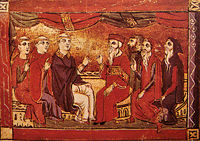- Code of Canons of the Eastern Churches
-

This article is part of a series on the
Law of the Catholic ChurchCodes of Canon Law
- 1983 Code of Canon Law
- Code of Canons of the Eastern Churches
- 1917 Code of Canon Law
- Concordance of Discordant Canons
- Decretals of Gregory IX
- Anglicanorum Coetibus
- Benedictus Deus
- Ex Corde Ecclesiae
- Fidei Depositum
- Indulgentiarum Doctrina
- Pastor Bonus
- Providentissima Mater Ecclesia
- Sacrae Disciplinae Leges
- Ut Sit (see also Opus Dei)
- Universi Dominici Gregis
Canon Law of Vatican II
Other
- Canon 915
- Latae Sententiae Excommunication
- Motu Proprio
· WikiProject Canon Law
The Code of Canons of the Eastern Churches (CCEO) is the title of the 1990 codification of the common portions of the Canon Law for the 22 of the 23 sui iuris Churches in the Catholic Church. The Roman or Latin rite Church is guided by its own particular Canons. The 22 sui iuris Churches which collectively make up the Eastern Catholic Churches have been invited by the Catholic Church to codify their own particular laws and submit them to the pope so that there may be a full, complete Code of all religious law within Catholicism.
Pope John Paul II promulgated CCEO on October 18, 1990, by the document Sacri Canones.[1] The Code came into force of law on October 1, 1991.[2]
Titles
The text of the CCEO is divided into 31 sections, 30 titles and a section of preliminary canons.
Preliminary Canons
The 6 preliminary canons deal with scope and continuity, what is affected by the CCEO and how prior legislation and customs shall be handled.
Can. 1 The CCEO regards solely the Eastern Catholic Churches unless otherwise mentioned.
Can. 2 The CCEO is to be assessed according to the Ancient Laws of the Eastern Churches.
Can. 3 The CCEO does not legislate on liturgical matters and therefore the Liturgical Books are to be observed unless contrary to the Canons of the CCEO.
Can. 4. The CCEO neither degrades or abrogates treaties/pacts entered into by the Holy See with nations/political societies. Therefore, they still have their force, notwithstanding any prescriptions of the CCEO to the contrary.
The Rights and Obligations of All the Christian Faithful
This section defines the Christian faithful and catechumens.
It expresses that the People of God have the obligation to: maintain the faith and openly profess the Faith, maintain communion, promote the growth of the Church, listen to pastors, let pastors know their opinions on matters of the good of the Church, call private associations 'Catholic' only when approved by the bishop, preserve the good reputation and privacy of all people, help with the needs of the Church and promote social justice including providing aid to the poor from their own resources.
It also expresses various rights of the faithful.
The canons in this section are numbered 7-26.
Part of a series on the
Eastern Catholics
Alexandrian-rite Churches Coptic · Ethiopian West Syrian rite Churches Maronite · Syriac · Syro-Malankara Armenian-rite Churches Armenian Church Byzantine-rite Churches Albanian · Belarusian · Bulgarian Croatian · Greek · Hungarian Italo-Greek · Macedonian Melkite · Romanian · Russian Ruthenian · Slovak · Ukrainian East Syrian rite Churches Chaldean · Syro-Malabar  Catholicism Portal
Catholicism PortalChurches Sui Iuris and Rites
Churches sui iuris
A church sui iuris is "a community of the Christian faithful, which is joined together by a hierarchy according to the norm of law and which is expressly or tacitly recognised as sui iuris by the supreme authority of the Church" (CCEO.27) . The term sui iuris is an innovation of CCEO (Codex Canonum Ecclesiarum Orientalium - Code of Canons of the Oriental Churches) and denotes the relative autonomy of the Oriental Catholic Churches. This canonical term, pregnant with many juridical nuances, indicates the God-given mission of the Oriental Catholic Churches to preserve their patrimonial autonomous nature. The autonomy of these churches is relative in the sense that they are under the authority of the Bishop of Rome.[3]
For a better understanding of the concept of church sui iuris see, Žužek, Understanding The Eastern Code, pp. 94–109. “Una Chiesa Orientale cattolica è una parte della Chiesa Universale che vive la fede in modo corrispondente ad una delle cinque grandi tradizioni orientali- Alessandrina, Antiochena, Costantinopolitina, Caldea, Armena- e che contiene o è almeno capace di contenere, come sue componenti minori, piú communià diocesane gerarchicamente riunite sotto la guida di un capo commune legittimamente eleto e in communione con Roma, il quale con il proprio Sinodo costituisce la superiore istanza per tutti gli affari di carattere amministrativo, legislativo e giudiziario delle stesse Communità, nell'ambitto del diritto commune a tutte le Chiese, determinato nei Canoni sancti dai Concili Ecumenici o del Romano Pontefice, sempre preservando il diritto di quest'ultimo di intervenire nei singoli casi” pp. 103–104.[3] A rough translation of this may be rendered "An Eastern Catholic Church is on part of the Universal Church in which lives the faith in a corresponding manner to one of the five great Eastern Traditions - Alexandria, Antioch, Constantinople, Chalcedon, Armenian - and which contains or is capable of containing, as its small marts, more community specific diocesan rule and the guide of a legitimately elected head of the community and in Communion with Rome, in which, with its own Synod, constitutes the highest law for all those affairs of an administrative character, legislative and guiding of its own community, in the aim of the direction common to all the Church, determined in the Holy Canons of the Ecumenical Councils or of the Roman Pontiff, always preserving the direction of the latter in individual cases."
According to the CCEO the Oriental Catholic Churches sui iuris are of four categories:
1.Patriarchal Churches:
The patriarchal church is the full-grown form of an Oriental Catholic Church. It is a community of the Christian faithful joined together by a patriarchal hierarchy. The patriarch together with the synod of bishops has the legislative, judicial and administrative powers within the ecclesiastical territory, without prejudice to those powers reserved, in the common law to the pope (CCEO 55-150). Among the Catholic Oriental churches the following hold patriarchal status: Maronite, Chaldian, Coptic, Syrian, Melkite, Armenian.[3]
2.Major Archiepiscopal Churches:
Major archiepiscopal churches are those oriental churches which are governed by major archbishops, assisted by a respective synod of bishops. These churches have almost the same rights and obligations of patriarchal churches. A major archbishop is the metropolitan of a see; he is chosen by the pope or recognised by him, and presides over an entire Eastern Church sui iuris. What is stated in common law concerning patriarchal churches or patriarchs is understood to be applicable to major archiepiscopal churches or major archbishops, unless the common law expressly provides otherwise or the matter is obvious. (CCEO.151, 152). The four major archiepsicopal churches are: the Syro Malabar, the Ukrainian Byzantine, the Syro Malankara Catholic and Romanian Byzantine.[3]
3.Metropolitan Churches:
This is a church which is governed by a metropolitan "sui iuris." Such a church is presided over by the metropolitan of a determined see who has been canonically elected and confirmed by the pope. He is assisted by a council of hierarchs according to the norms of law (CCEO. 155§1). The Catholic metropolitan churches are the Ethiopian Church and the Ruthenian Church.[3]
4. Other Churches:
Apart from the above mentioned forms of church there are other ecclesiastical communities which are entrusted to a hierarch who presides in accordance with the norms of canon law. (CCEO. 174). The following Oriental Catholic churches are of this status: Belarussian Greek, Bulgarian Greek, Macedonian Greek, Greek Byzantine, Hungarian Greek, Italo-Albanian, Slovakian Greek, Byzantine Church of the Eparchy of Križvci, Albanian Byzentine, Russian Byzantine. Altogether there are 22 oriental sui iuris churches in within the Catholic communion.[3]
The Supreme Authority of the Church
The Patriarchal Churches
Patriarchal Curia (Canons 114-125)
PATRIARCHAL AND MAJOR ARCHIEPISCOPAL CURIA: The bishops of the curia (maximum three); Permanent Synod:Patriarch + 4 bishops (3+1)and 4 substitutes (Quasi - Permanent Synod Patriarch + 2 bishops); Chancellor, vice-chancellor, notaries, chancery; Patriarchal Finance Officer (administrator of the goods of Church); Other Aspects like archieves, inventary, financial sources of curia; The commissions: For the Liturgy, Ecumenism, Catechism, Evangelization, Preparation of the Synod of Bishops, Preparation of the patriarchal Assembly, censor of Books and the other commissions under the Patriarchal Authority; The Ordinary Tribunal The president, the judges(9), the administrative officials (auditors, promotor of justice, difendor of the bond, notaries, advocates, procurators, experts, interpreters, etc.); The organs connected to patriarchal curia: All organs of patriarchal church who collaborate in the administration of the Patriarchal church, including superior tribunal, moderator general of the administration of justice, a group of bishops for recourse, patriarchal procurator in Rome, Roman curial organs, curia of other patriarchal churches, etc. (As far as the curia is concerned, it is the same for the Patriarchal and Major Archiepiscopal Churches)[4]
The Major Archiepiscopal Churches
Metropolitan Churches and Other Churches Sui Iuris
Eparchies and Bishops
Exarchies and Exarchs
Assemblies of Hierarchs of Several Churches Sui Iuris
Clerics
Lay Persons
Monks and Other Religious as well as Members of Other Institutes of Consecrated Life
Associations of the Christian Faithful
Evangelization of Nations
The Ecclesiastical Magisterium
Divine Worship and Especially the Sacraments
Baptized Non-Catholics Coming into Full Communion with the Catholic Church
Ecumenism or Fostering the Unity of Christians
Persons and Juridic Acts
Offices
The Power of Governance
Recourse Against Administrative Decrees
The Temporal Goods of the Church
Trials in General
The Contentious Trial
Certain Special Procedures
Penal Sanctions in the Church
The Procedure for Imposing Penalties
Law, Custom, and Administrative Acts
Prescription and the Computation of Time
See also
- Canon law (Catholic Church)
- Code of Canon Law
- Roman Catholic (term)
References
- ^ AAS82 (1990) pp. 1033-1063
- ^ Dr. Thomas Kuzhinapurath, Salvific Law: Salvific Character of CCEO, An Historical Overview, Malankara Seminary Publications, Trivandrum, 2008, p.79
- ^ a b c d e f [1]
- ^ Dr. Francis Eluvathingal, Patriarchal and Major Archiepiscopal Churches in the Eastern Catholic Legislations based on CCEO Canon 114-125.
External links
- Codex canonum ecclesiarum orientalium, original text in Latin
- "Code of canons of Oriental Churches", English translation
- Code of Canons of the Eastern Churches PDF format
- Text of Sacri Canones, issued by Pope John Paul II at the promulgation of the Code of Canons of the Eastern Churches
- A Theological Study on CCEO
Categories:
Wikimedia Foundation. 2010.
